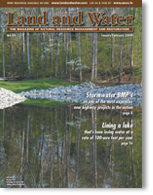Features Available Online
We Can Survive Anything Except Poor Quality
by Leo Holm, P.E.
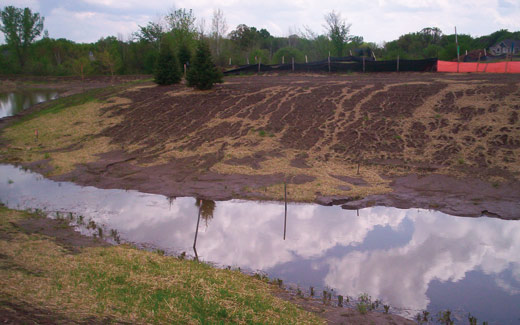
In order to control erosion for the customer and meet permit requirements, a higher level of quality is required.
While touring an erosion control product manufacturing plant facility I could not help but notice the above slogan on the wall of the main plant. The sign bearing the slogan was huge and the lettering was crystal clear. It was mounted high on the inside wall for everyone working in the plant to see. Being a skeptic, I wondered if they really do this or if it is just a slogan. After touring the modern well-organized facility and the product produced, I came to the conclusion that they took the slogan message very seriously.
| I am concerned that with all the competitive bidding on construction projects for work, and the keen competition in the erosion control product manufacturing and distribution industries for sales, that quality is the first item on the cutting table. |
So my friends and colleagues in this erosion control industry, how are we doing on quality? Are too many of us brushing this off? Are we saying that quality is a construction quality assurance and control (QA/QC) issue or a manufacturing issue? Is quality getting better, staying the same or getting worse? I am concerned that with all the competitive bidding on construction projects for work, and the keen competition in the erosion control product manufacturing and distribution industries for sales, that quality is the first item on the cutting table. Irregardless of how we are doing, the needs and expectations for quality are higher. Why do I say this? Because we have a higher level of performance that we must provide in order to meet the new erosion and sediment control standards relating to protecting our water resources and permit compliance. If we as an industry are staying at the same level of quality we are actually falling behind. And we have let the customer down. There are many customers in the construction industry that rely on us for quality erosion control products and services. The bottom line is that quality is necessary to protect the health and reputation of this industry.
| About a month ago an erosion control product distributor asked me, “If 2 inches of bituminous were placed in a road instead of the required 2 1/2 inches, it would be rejected. Why aren’t inferior erosion control products rejected at the same level as other construction materials?” |
Whenever quality is mentioned it is human nature to relate to a manufacturing process or a product that is produced. For example, how well is an erosion control product such as an erosion control blanket manufactured or produced? Does the product have uniform distribution of material throughout the blanket? Is it bound or stitched properly with netting reinforcement? Is the blanket the proper weight per square yard and the netting true dimension following quality manufacturing tolerances? Are inferior blankets not meeting quality standards pulled from the assembly line and not sold later as a lower grade B or as “seconds”? I have specified, recommended, developed specifications and helped install erosion control blankets since 1967. Throughout all those years I have seen the quality of the blankets produced vary. However, the blankets that I have seen produced by most manufacturers in the last 4-5 years are much more uniform. I am thankful for the work that organizations such as the Erosion Control Technology Council is doing to improve quality in our industry.
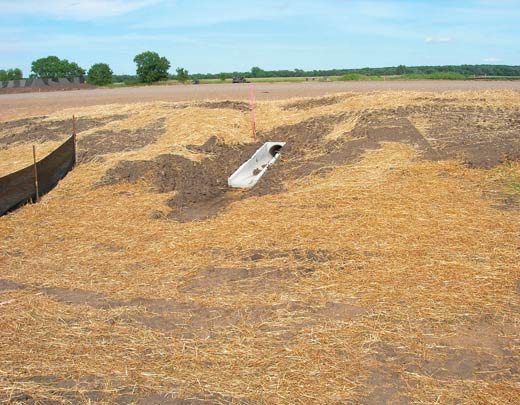
How can we control erosion if the mulch is spread in streaks and gobs and not tucked into the soil?
We have some major areas where we need to improve quality in this industry. Why do I say this? First of all we have all have seen some of the same blatant, inappropriate, installation practices and specification evasion described by Peter McRae in the Sept/Oct2006 issue of Land and Water. Peter shared such project experiences as “weekend seeding”, the seed tag switch and other specification evasion practices encountered during seeding. In his article Peter did an excellent job of describing many different evasion scenarios. There are perceived thoughts that quality isn’t that big of a deal, that projects are awarded on the basis of low bid, that there really aren’t any rewards for quality and that there are few substantial penalties for avoiding the specifications. If a supplier or a contractor on a project can substitute a less quality /less costly item or take a short cut during installation, they perceive there is more money in their pockets. Over the years, I have had several reliable suppliers complain to me about inferior products being shipped to projects by their competitors. I know of at least one State Highway project where a large installation of erosion control blanket was rejected. Upon detailed inspection, the blanket installed had large open areas void of material and the netting was of a lighter weight. Upon further investigation, it was discovered that the blankets were actually seconds or grade B quality.
A month ago an erosion control product distributor asked me, “If 2 inches of bituminous were placed in a road instead of the required 2 1/2 inches, it would be rejected. Why aren’t inferior erosion control products rejected at the same level as other construction materials?” I didn’t have a good answer for his question. What could I say? I told him I would write an article. I would carry the message that quality is a serious issue and I would ask my colleagues in this industry to join in the fight.
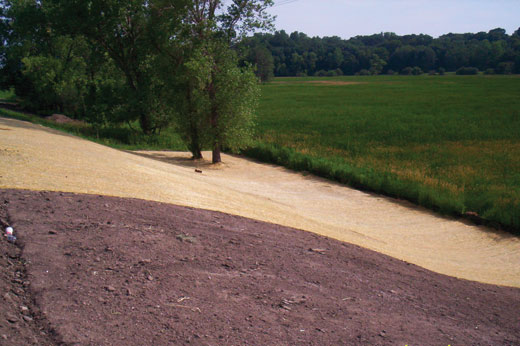
We need quality installations to protect our water resources.
This same distributor did an analysis of the number of square yards of erosion control blanket sold by their company in relation to the number of staples sold over the same time period. The ratio of staples sold in relation to the blankets was very low. In fact the ratio was less than 1/3 of the required staples. This means that there are a bunch of blankets installed that aren’t fastened down according to specifications or the manufacture’s recommendations. In my discussions with several manufactures, they have identified improper installation as a major issue. The lack of proper installation directly affects performance and future use of their products. The engineers and designers specifying products on their projects are also affected. An improperly installed product will not perform to the expected design parameters and there is a high risk of failure. Product failure means erosion and probably sediment transported offsite.
| You can’t produce a part to a tolerance of 0.01 inch with a machine that has a tolerance of 0.5 inches. So why do we try to place mulch with equipment that has inherent problems of spitting mulch out in streaks and gobs? |
So far I have discussed blanket installations and Peter McRae has discussed seeding issues. Its hard to top Peter’s description of areas not even seeded. How about mulch? Lately I have seen so many areas where the mulch is “spread” in streaks and gobs. I relate the problem to the equipment used. You can’t produce a part to a tolerance of 0.01 inch with a machine that has a tolerance of 0.5 inches. So why do we try to place mulch with equipment that has inherent problems of spitting mulch out in streaks and gobs? How about silt fence? How many of us have seen silt fence not tucked in and flapping in the wind? How can we meet stringent permit requirements if we have to worry if the blankets are stapled, if the mulch is uniform, if the silt fence is tucked in, or if the area is even seeded?
Quality also relates to process. When shortcuts are taken or steps are eliminated in the process serious problems can develop. For example, a friend of mine put on some decals on his truck. The instruction on the decals were to prepare the surface first with a special cleaner. My friend didn’t buy the cleaner and just washed the area prior to putting on the decals. You guessed it, within a week the decals pealed off like pealing a potato. To get proper seed establishment and mulch anchoring, the area first needs to be tilled and the soil loosened. I see the tillage step being eliminated. I see sod placed on ground hard enough to land a DC 10. How will the plants ever survive?
| A workmanship and quality control schedule was also developed and included in the specifications. If the workmanship falls below a stated threshold level, the work is unacceptable and has to be redone. There is no partial payment. The area is either redone or no payment is made. |
One of the most frequent frustrations that I have heard from other storm water professionals is getting the BMP’s installed and maintained during construction. How can we implement the provisions of the project’s Storm Water Pollution Prevention Plan (SWPPP) if we have to worry whether the erosion control subcontractor will show up? Quality also includes proper and timely service.
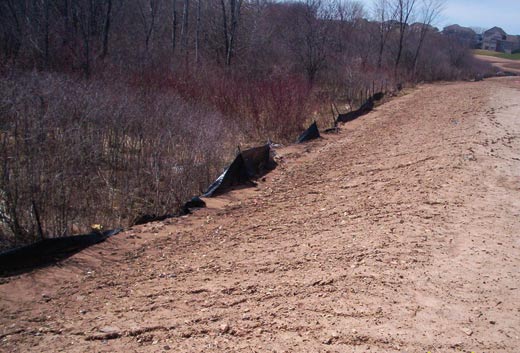
How can we meet permit requirements if we have to worry if the erosion control subcontractor will show up? Quality also means quality service.
Is this industry serious about providing quality products and services so that the end user can control erosion, have a good project outcome and meet permit requirements? In looking at this question from the quality aspect, it’s a checkered field. Lets explore some options.
In Peter Mc Rae’s article he identified the low bid system as a major contributor to the lack of quality. The low bid system sends a strong message that lowest cost is the desired outcome. However, it’s the lowest bid that meets specification requirements. Specification requirements have to be met first: its pass/fail. So, I am a proponent of having consequences also spelled out in the specifications. For example, after an incident of “weekend seeding” as described in his article, we developed a specification that work done outside the normal business hours without prior approval was unauthorized work and no payment would be made. Double deduction type specifications were prepared for missing ingredients in seed mixtures. If ingredients were missing in the seed mixture used, the area is reseeded at no cost plus the value of the original missing ingredients is also deducted.
A workmanship and quality control schedule was also developed and included in the specifications. If the workmanship falls below a stated threshold level, the work is unacceptable and has to be redone. There is no partial payment. The area is either redone or no payment is made. The rework schedule included such things as blankets not stapled properly, improper mulch application, improper seeding methods, silt fence not tucked in, ditch checks not notched in or staked and the installation of several other erosion control BMP’s.
Having the rework schedule, the possibility of double deductions and other consequences spelled out in the specifications has definitely helped and has relieved project engineers/project inspectors from having to make judgment type decisions in the field. They can use the consequence specifications as a project management tool that there are consequences of improper installations. As I stated, the inclusion of consequences into the specifications has definitely helped. However, there are improvements that still need to be made. Quality should be a routine practice.
| Their answer was “if the bid is 20% below your project or application estimate, there’s high probability that you will not be getting the performance or the quality you are looking for.” Bids that are 20% or more below the engineers estimate are a red flag. |
When we prepare specifications for projects we have to ask ourselves “have we provided a loop hole in the specifications for providing less quality?” For example, we frequently do a detailed analysis and spec out a particular product for a specific application. We go through the calculations and feel confident that this is the product that will perform. Then we include the loop hole in the specifications… Or approved equal. I hate the wordage approved equal. It’s an invitation to the whole world that you will accept something different than specified. Who will make the decision of what is approved? What will be the basis to determine whether the substitution is equal? Everyone bidding the project will try to figure out how they can provide something less and make the substitution. Every product has a range for its performance. The application of one product may be at the very top of its performance range. While the application of the product specified may be at the bottom or middle of its performance range. Are these two products approved equal? We have to change our logic and be able to spec out the products that we know will perform.
We also have to ask ourselves if there are some signals that quality could be compromised on a particular project or a particular application? For example, engineering cost estimates are usually prepared for projects and the various line items in the bid documents. What is the message when the bid is considerably lower than the engineer’s estimate? To provide some guidance I have asked several reputable erosion control product suppliers what would be a good rule of thumb? Their answer was “if the bid is 20% below your project or application estimate, there’s high probability that you will not be getting the performance or the quality you are looking for.” Bids that are 20% or more below the engineers estimate are a red flag.
As I stated previously, there is a higher level of performance that must be met in order to effectively control erosion on projects and meet permit requirements. In order to meet a higher level of performance, quality must be improved. Quality of service is extremely important. Quality installations are essential and we must always have consistent performing quality products. I am grateful for the ECTC, the IECA, CPESC and others that are emphasizing professionalism and quality in this industry.
There are quality manufacturers, distributors and erosion control contractors in this industry. They are the leaders. As a beginning step we must listen to their message about quality issues. Then we must take action and include workmanship requirements and consequences in project specifications, eliminate the use of approved equal, educate the project managers and inspectors that are doing the QA/QC on projects, rigorously enforce the specifications, be firm and tenacious and above all practice due diligence. ![]()
For more information contact Leo Holm at (651)967-4651 or e-mail: Lholm@bonestroo.com.

